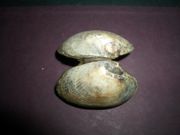Venerupis philippinarum
From ize
| Taxonomy | |
|---|---|
| Kingdom: Animalia | |
| Phylum: Mollusca | |
| Class: Bivalvia | |
| Subclass: Heterodonta | |
| Order: Veneroida | |
| Family: Veneridae | |
| Superfamily: Veneroidea | |
| Genus: Venerupis | |
| Species: philippinarum |
Contents |
Venerupis philippinarum (Adams & Reeve, 1850)
Tapes philippinarum, Ruditapes philippinarum, Venus philippinarum, Tapes japonica, Tapes semidecussata, Paphia bifurcata, Tapes quadriradiatus, Tapes violascens
Common names
Japanese Littleneck, Manilla clam, Steamer Clam, Filipino Venus, Japanese Cockle, Japanese Carpet Shell
Size
To 7.5 cm across, up to 3.5 cm width. Elongate, oval, and sculptured with radiating ribs (Morris, 1980).
Range & Habitat
Native from s. Siberia to China, introduced with oyster spat from Japan, n. BC to c. California. Mid to low inter-tidal zone, occurs in bays and estuaries, in mud, sandy mud and cobble, buried 2-4 cm below the surface.
Color
Highly variable! Commonly grayish, greenish, brownish, yellow or buff with distinct dark or light colored, with triangular mottled markings that begin at the umbo and disperse outwards. Often times, their true color can be distorted by dark gray staining, caused by anoxic mud. The foot of live specimens are an orange color.
Identification
Inner ventral margin smooth, ligament prominent, elevated above dorsal margin; siphons separate at tips (Carlton, 2007).
Misidentification
Commonly misidentified as Protothaca staminea, philippinarum shells are more elongate than staminea. Internally, philippinarum has yellowish valves, with a purple suffusion near the posterior margin. Protothaca staminea lacks this purple suffusion. May be found together with Protothaca staminea, but tends to reside at slightly higher tide levels.
Life History
V. philippinarum breeds in the summer, larvae then continue to grow slowly (especially in areas of crowding), reaching maturity at 1-2cm, and will live from 7-10 years. A Non-native species, V. philippinarum was introduced during the 1930’s, brought over from Japan with oyster spat from Japanese oysters. It is now extremely common amongst the Pacific coast, and is highly prized for food (Morris, 1980). V. philippinarum is also capable of withstanding salinities as low as 30-50 percent of that of pure sea water, and can additionally tolerate levels of high pollution.
Natural History
Water is drawn in and out of this clam by siphons that protrude from the posterior end of the shell. In this species, the siphons are mostly fused—separate at the tips. These siphons are short, relative to other clams, which hinders them from burrowing deeply—and thus giving them the common name “littleneck clam”.
Predators
Moon snails (Euspira lewisii), the Atlantic oyster drill (Urosalpinx cinerea), Dungeness crab (Cancer magister), Red rock crab (Cancer productus), Panopeid crab (Dyspanopeus sayi), Bat rays (Mylobatus californicus), flounder, sturgeon, willet (Catoptrophorus semipalmatus), Ring-billed gulls (Larus delawarensis), and raccoons (Procyon lotor), and undoubtedly many others.
Sources
Carlton, J. T. (2007). The light and smith manual intertidal invertebrates from central califorina to oregon. Berkeley and Los Angeles, CA: University of California Press.
Cohen, Andrew (2005). Guide to the exotic species of San Francisco Bay. Retrieved June 7, 2005, from http://www.exoticsguide.org/species_pages/v_philippinarum.html
Dudas, S.E., McGraw, I.J., & Dower, J.F. (2005). Selective crab predation on native and introduced bivalves in British Columbia. Journal of Experimental Marine Biology and Ecology. 325, 8-17.
Hanby, B (2005). Marine life of the pacific northwest. Madeira Park, BC: Harbour Publishing.
Kozloff, E (1993). Seashore life of the northern pacific coat. Seattle, Wa: University of Washington Press.
Michele, M. (2007).Predatory behavior and preference of a successful invader, the mud crab Dyspanopeus sayi (Panopeidae), on its bivalve prey. Journal of experimental marine biology and ecology . 312, 385-398.
Morris, R.H., Abbott, D.P., & Haderlie, E.C. (1980). Intertidal Invertebrates of California. Stanford, CA: Stanford University Press.
External links
Other Links
Guide to the Exotic species of San Francisco Bay: http://www.exoticsguide.org/species_pages/v_philippinarum.html
Biota @ Evergreen: http://biota.evergreen.edu/
Suggested Reading
Marine Life of the Pacific Northwest—Bernard Hanby
Seashore Life of the Northern Pacific Coast—Eugene N. Kozloff
Marine Invertebrates of the Pacific Northwest—Eugene N. Kozloff




